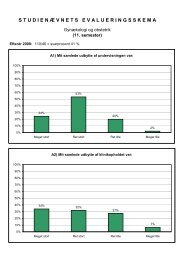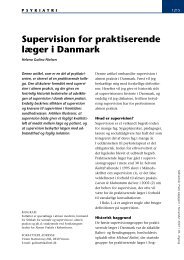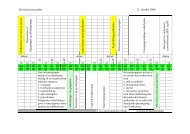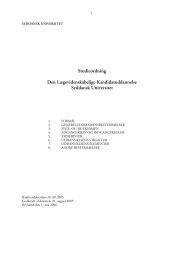shared deliberate practice
shared deliberate practice
shared deliberate practice
Create successful ePaper yourself
Turn your PDF publications into a flip-book with our unique Google optimized e-Paper software.
Shared Deliberate Practice 221experienced players play an important part in maintaining concentration in training by beingrole models that exhibit high concentration necessary for maintaining high quality training.Feedback and Role ModelingWe will discuss feedback (mainly verbal but as mentioned earlier also nonverbal) fromthe coach and role models. As already mentioned the more experienced players guide andgive the other players feedback. The <strong>deliberate</strong> <strong>practice</strong> framework emphasizes that aspiringexperts’ learning is often facilitated by verbal feedback from a coach who makes athletesaware of the aspects that they need to improve, but this framework does not describe whatmakes the guidance and feedback an efficient learning resource other than its propositionalsubstance. Our study indicates that the style of the relationship between the guiding playerand receiving player influences the effectiveness of the verbal feedback. Sille (the youngerplayer) states that her relationship with Mette influences how she perceives Mette’s guidance:We played a game in which I was substituted for Mette and [then] she guides me inwhat I have to do and when I have to do it before I enter the court. This way I can reallyuse it [the guidance] and feel confident with what I’m doing. When she tells me to do it,then I have the courage to do it. That is to take a step, go forward and take the goodplayer [in front of me] out. (Sille)However, Sille experiences Mette’s guidance as “an extra hand” that enables her to beconfident in her operations.This is an example of verbal feedback and imitation as a result of the relation that Sillehas developed to Mette over the years. Throughout the years she has followed Mette’s gameson television and she admires Mette’s style of playing. She mirrors herself in Mette, becauseshe has the same build and the same defensive position in the team. Thus, Sille sees Mette asa kind of role model.Mette’s guidance highlights critical aspects which she herself might have encountered onthe court and which Sille must be aware of in her defensive play. However, the guidanceseem to assist Sille’s performance, not only because of their content, but also because they areput forward by Mette who – in Sille’s eyes – “is so experienced and on top of things, so I trustthat what she tells me is correct.And I haven’t experienced it not being correct yet” (Sille). Sille’s actions seem to bebacked up and supplemented by Mette’s richer experience, because her perception of theguidance is influenced by her practical and imagined relationship to Mette. This guidanceseems to modify Sille’s practical relationship with the particular defensive context, and makeher capable of performing timed and confident defensive operations. Since Mette is a rolemodel for Sille her words carry a greater weight.This could be interpreted an instructional nudge which according to Sutton become aform of “scaffolding that support[s] the embodied rebuilding of action” (Sutton et al. 2011,93).The interaction between Mette and Sille show that the social context (including itsrelational significance) is important to the feedback. For instance reflecting upon imitationSofie mentions the importance of the experienced player caring for her learning:
















